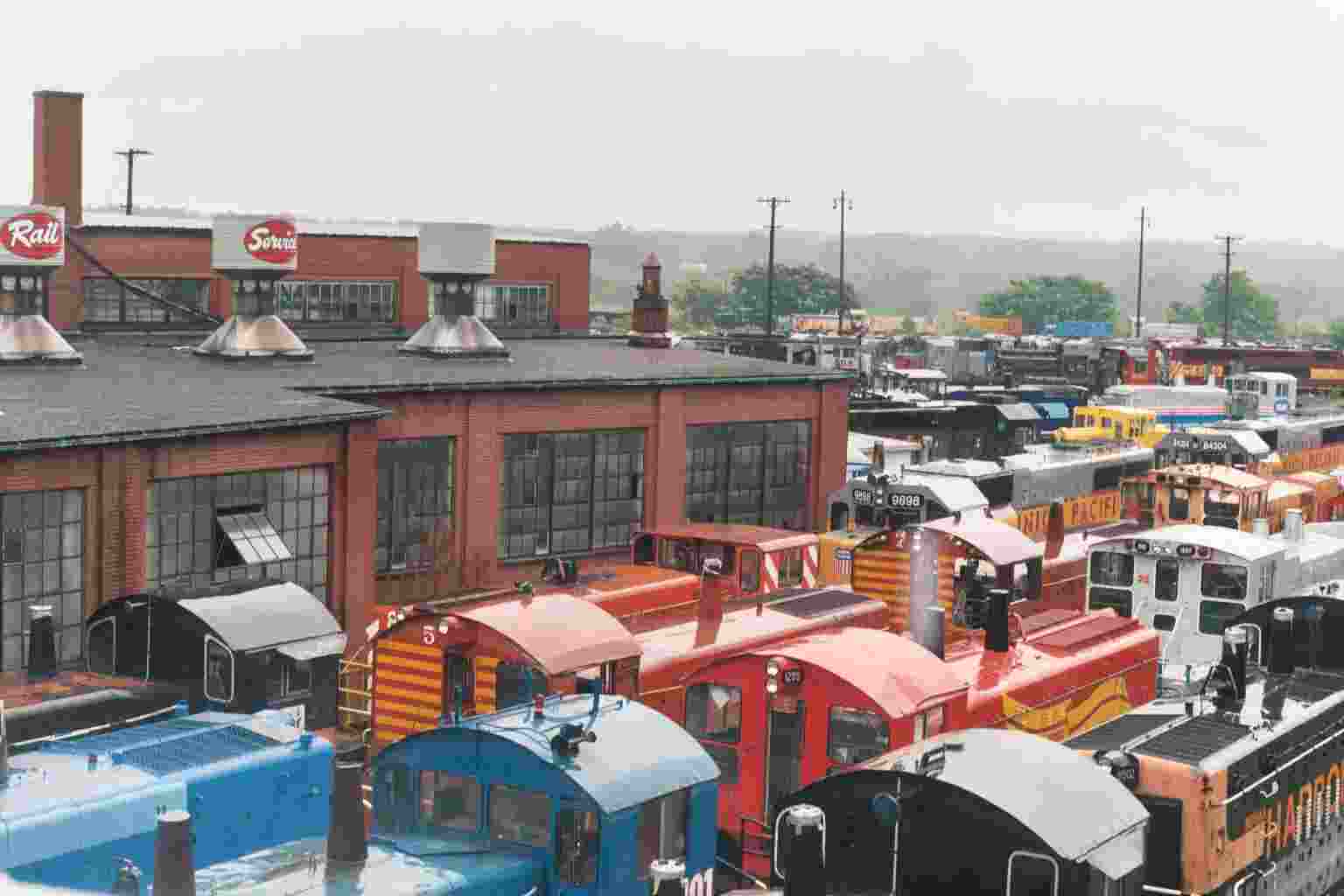 View of Larry's Truck and Electric from Ohio Avenue Bridge, McDonald, OH September 19, 2003 |
Larry's Truck and Electric of McDonald, Ohio, has become well known in recent years as a scrapper, lessee, and reseller of locomotives. The Erie Lackawanna Historical Society was able to gain admission to the huge LTE Rail Services lot on September 19, 2003, as part of its annual meeting.
LTE Rail is most recently notable for disposing of large quantities of units from Union Pacific and CN, many of which can still be found on its lot in various stages of disassembly. Some units are in running condition and are resold or leased out. The rest are scrapped. However, LTE has been in this business for some years, there's a huge backlog of units waiting for scrapping, and the dead lines must contain hundreds of first- and second-generation units from Amtrak, UP and component roads, CN and component roads, CP, VIA, and many others. The view above shows just a part of the lot, which occupies the former Youngstown and Northern enginehouse (left in the photo), as well as trackage belonging to the former US Steel McDonald Works (out of sight).
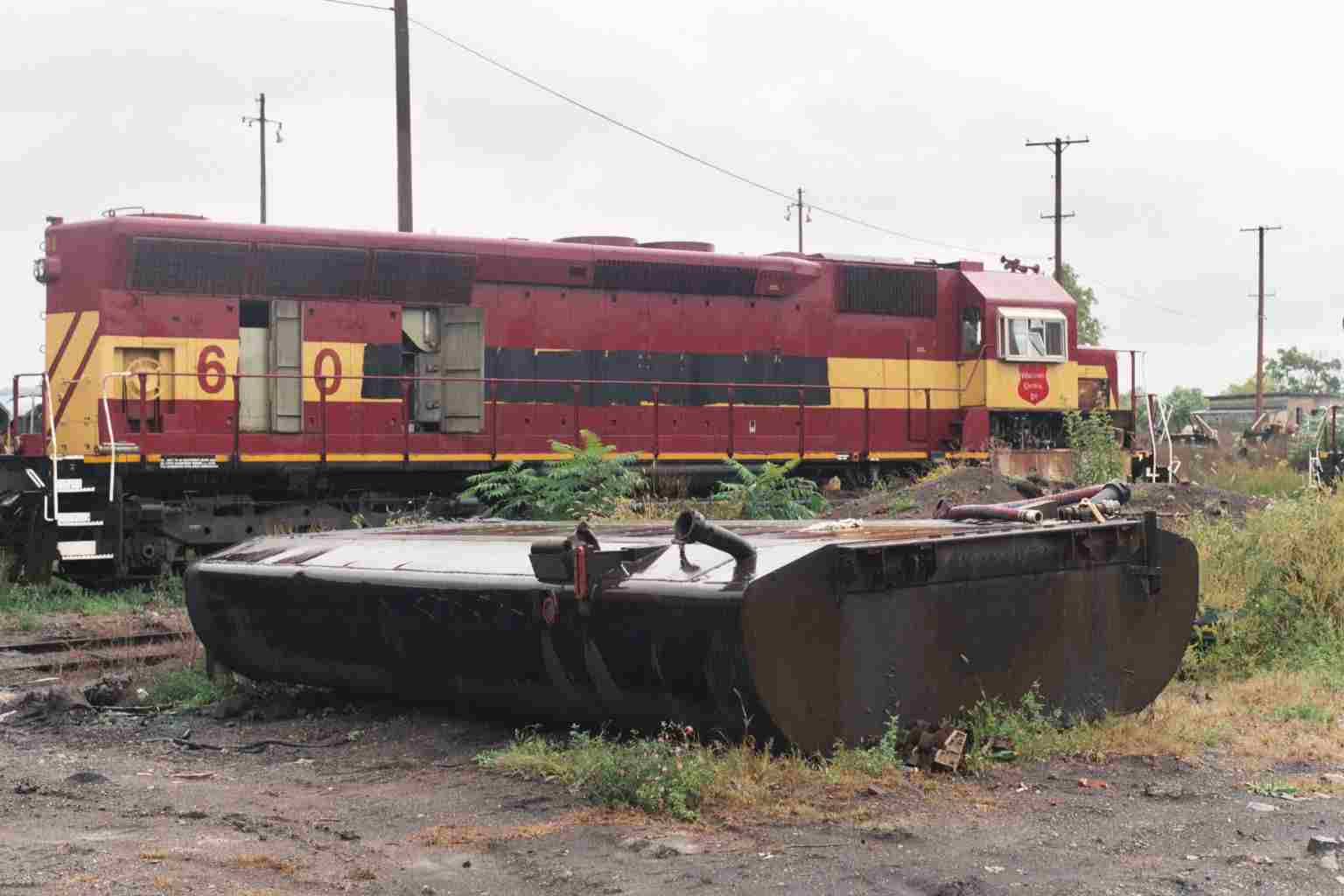 Awaiting Its Fate: ex-Wisconsin Central SD45 at Larry's Truck and Electric September 19, 2003 |
Just before the ELHS visited, the news was that LTE Rail had already scrapped a number of ex-Wisconsin Centrol locos they'd been sold by CN. However, we saw several WC SD45s still intact on the lot, but not likely to last much longer. An F45 was in one of the dead lines, too, but not photographable.
The day we visited was the tail end of Hurricane Isabel; schools in Ohio had been closed, and Amtrak had annulled its westbound through Youngstown to Chicago.
LTE Rail kept working, and we visited as well -- real railfan dedication.
Many of these photos were made in heavy rain.
One of us chatted with an employee and sympathized with his work in the rain.
"It ain't snowing yet," was his reply.
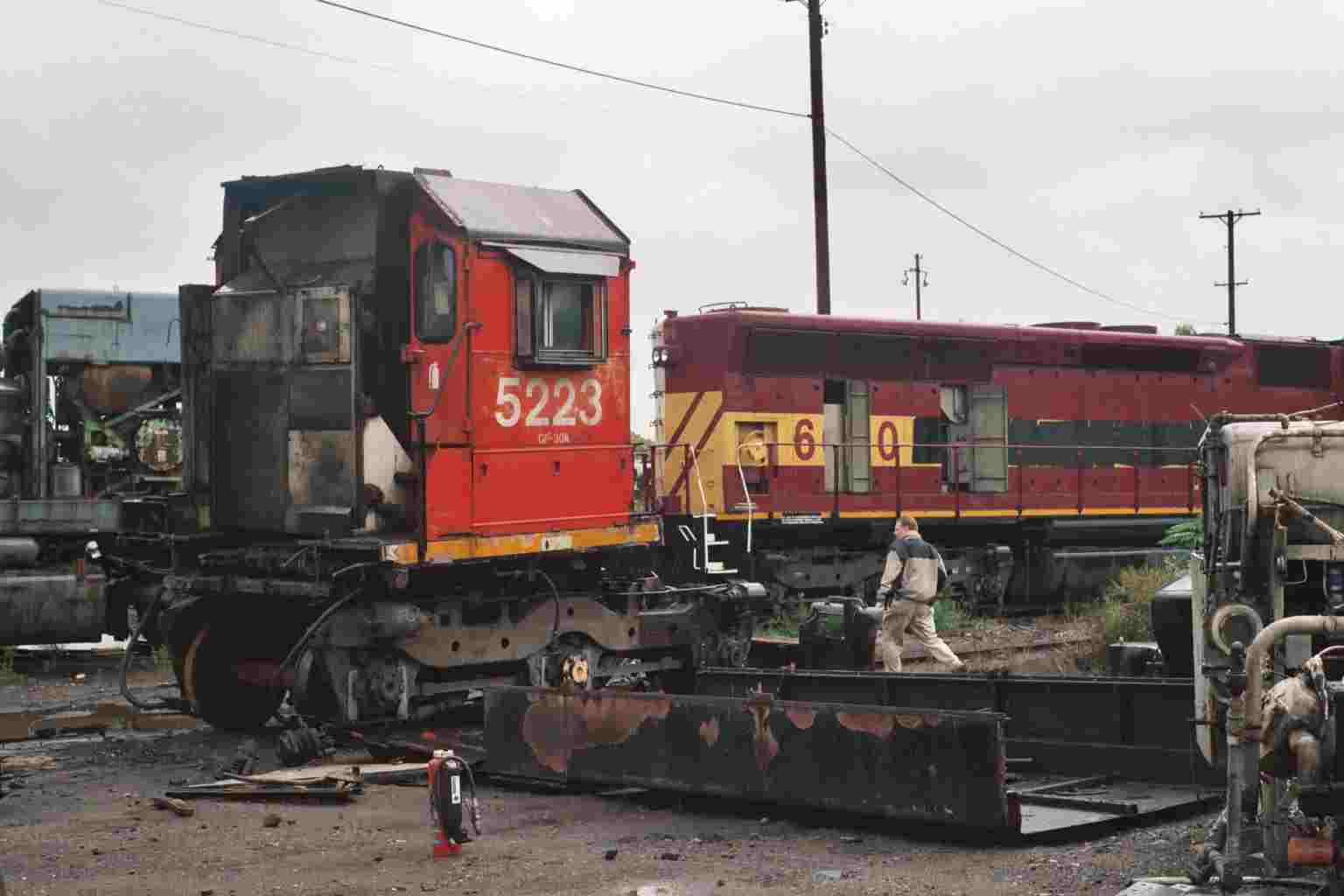 What's Left of CN SD40 5223 September 19, 2003 |
The photo to the right shows the scrapping process somewhat farther along.
Scrapping generally seems to begin with the long hood, removal of the prime mover and other equipment, and cutting up the frame behind the cab. That's the electrical cabinet sticking out to the left of CN 5223's cab. The front of the loco was to the right.
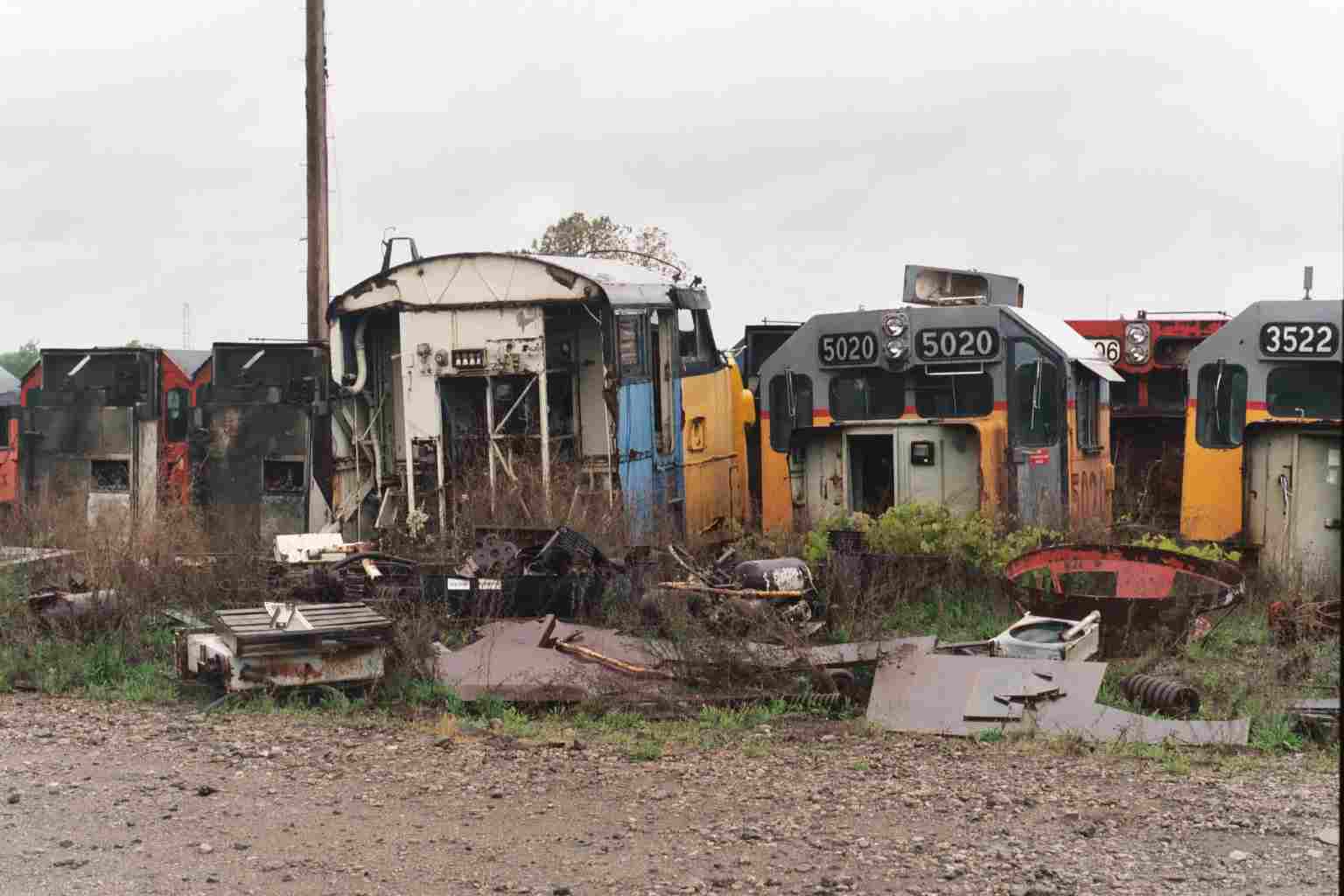 Assorted Cabs on Lot September 19, 2003 |
The last items left always seem to be the cab and electrical cabinet, and there are long lines of cabs on the lot, some of which you can see in the photo at left. Left of center is what appears to be a former VIA FP7.
In addition to the more identifiable parts of locos, there are many other bits and pieces scattered around the lot, more or less at random. These include prime movers, generators, traction motor blowers, wheel assemblies, traction motors, trucks, fans, and fuel tanks.
There's a definite feel of a "pull your own parts and save" auto salvage yard.
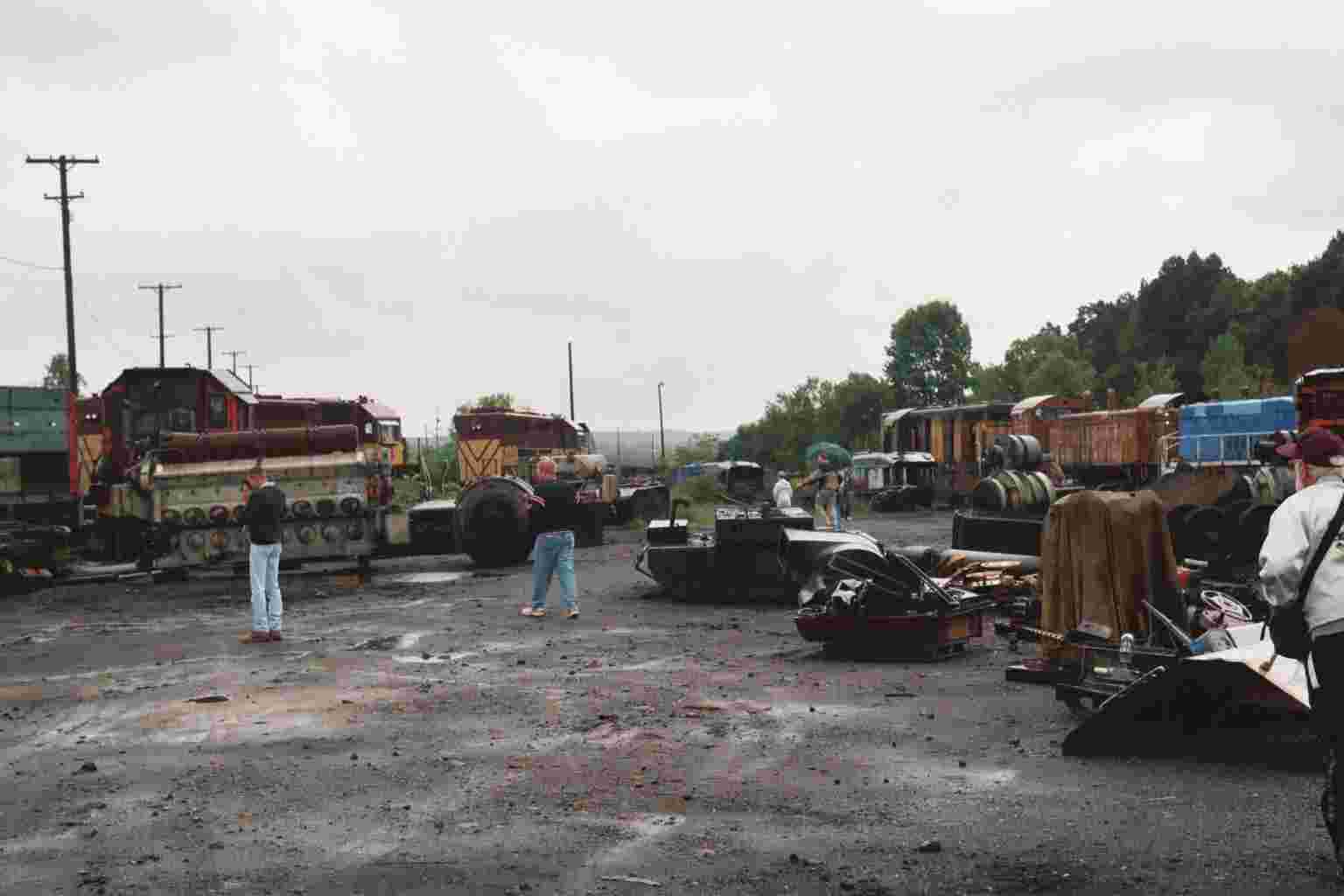 Looking North from LTE Rail Main Shop Area September 19, 2003 |
The LTE operation is so sprawling that it's not possible to get a single shot that covers everything. The photo to the right here gives an idea of the two main phases of the operation: on the left is the scrapping, and on the right are a few of the dead line locos that may or may not go out again as lease units.
As well as the ELHS members in the shot, you can see, from left to right, an EMD Spartan cab; an EMD 16-cylinder prime mover; a traction motor blower with the hulk of a loco ready for scrap behind it; an EMD fuel tank; some unidentifiable bits and pieces; and an EMD second-generation long hood end; behind it are some EMD switchers and GPs that may have a little life in them yet.
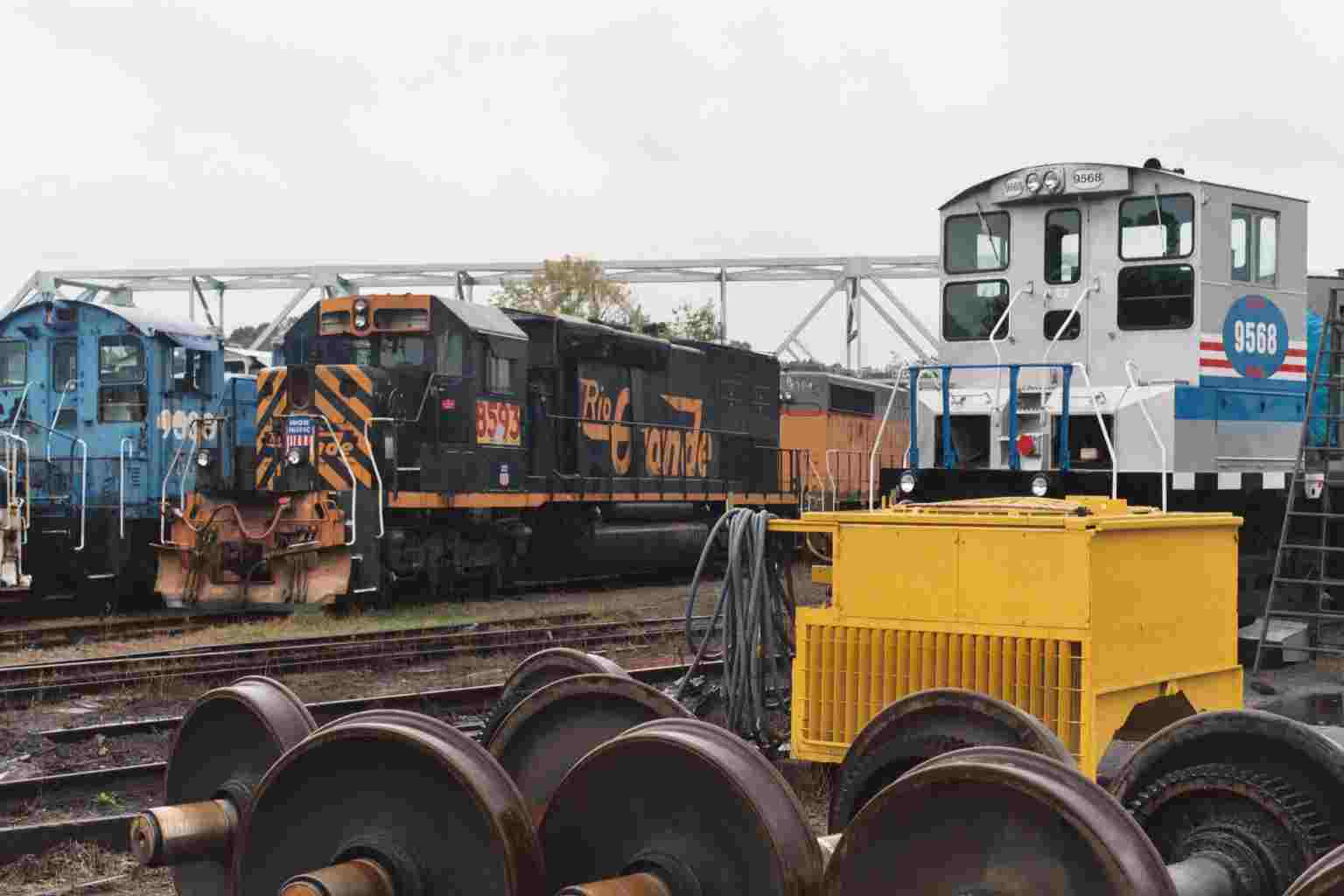 ex-UP 8593 (nee-DRGW SD40T-2) September 19, 2003 |
In the middle of this photo, which is more or less behind the photo above, are some UP units that may be in running condition and possibly be leased out or sold. The yellow box in the right foreground is a load test device that appears to be made from an SD50 dynamic brake unit. There are jumper cables looped to the left of the box that are connected to the electrical cabinet of a loco to be tested to see if it will load (and hence, apparently, to make the thumbs up-thumbs down decision).
Locos here move in and out of the load testing and inspection area under their own power, or may be shoved back and forth by an operable switcher (or by one of a number of beat-up trucks).
Following inspection, a loco may go back to the line of potential good units, or it may be shoved into the scrap area, or into other dead lines elsewhere on the lot.
Carl Arendt's Micro Layout Design Gallery is a popular site that covers designing and building so-called "micro layouts", which Carl defines as layouts less than three or four square feet in area. I've enjoyed watching the range of possible layouts expand, but one reservation I've had about many such layouts is that they've frequently relied on non-US prototypes, fanciful or "cute" concepts, and extra-small equipment -- four-wheel switchers and ore cars, for instance, or highly specialized and not fully prototypical On30 or Gn15 rolling stock. At one point I e-mailed Carl with these reservations (to which Carl and Emrys Hopkins made several very thoughtful replies). Why, I wondered, can't mainstream US diesel modelers make use of the micro layout concept, but take advantage of the operating quality in larger HO US-prototype diesel models? Now I think Larry's Truck and Electric gives one possible answer.
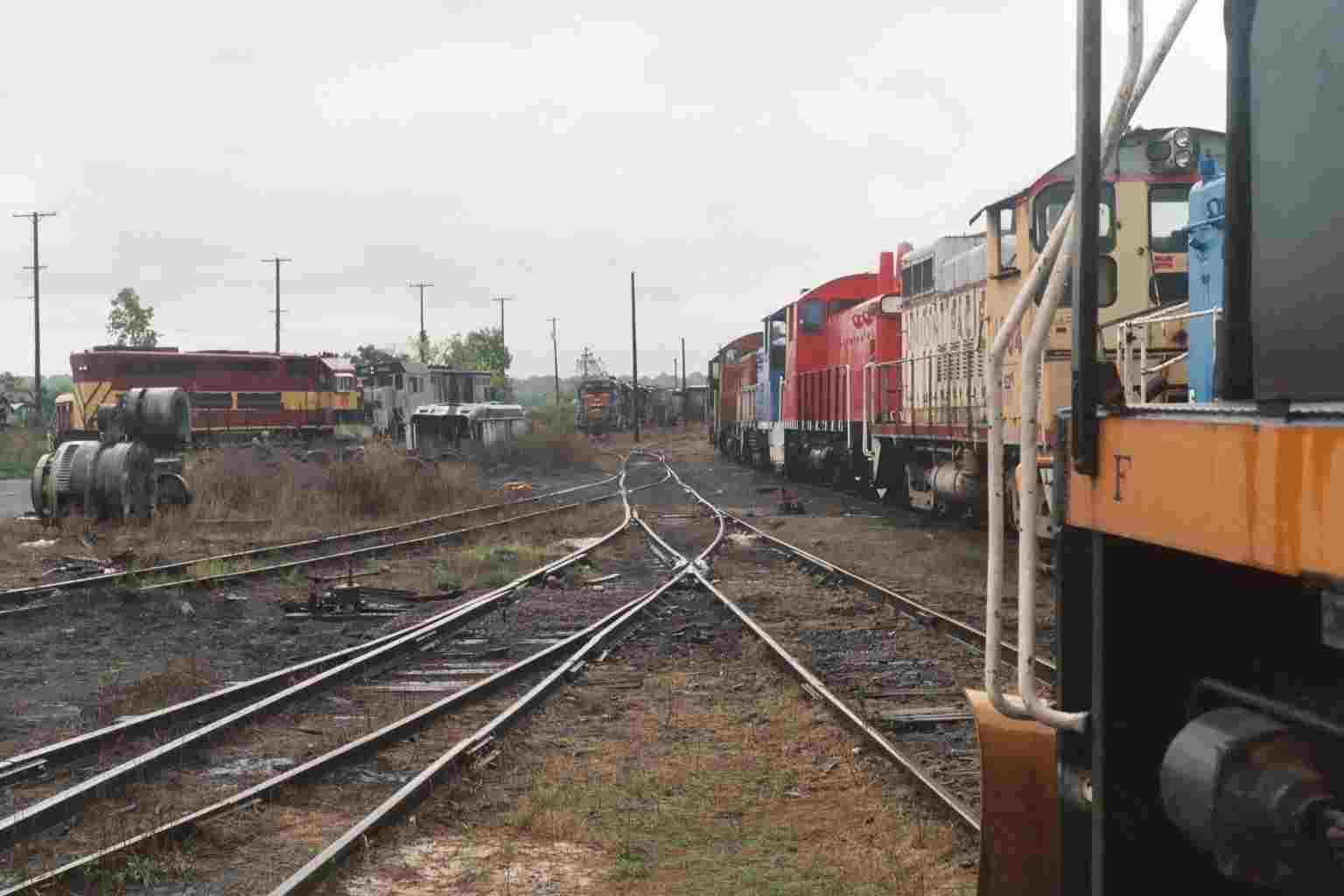 Inglenook Track Plan at LTE Rail September 19, 2003 |
If you choose "Shelf Switchers" on the left frame of his index page, expand that, and click on "Inglenooks", you'll find a schematic for "Walkley/Inglenook Designs", a traditional UK style of very small model layout. The basic track plan for this kind of layout is a pitchfork or simple yard ladder. A manifestation of this track plan is shown at left, in front of the Larry's Truck and Electric shop building. As Carl explains, the traditional operating pattern for an Inglenook layout is pretty much random -- you use a deck of cards or some other gimmick to tell you what piece of equipment to move from one track to another. This isn't for everyone, but there are limits to what you can do in less than four square feet.
I would set up three tracks (more if you've got the room) in more or less the "pitchfork" pattern shown in Carl's diagram. Looking in the same direction as in the photo, the rightmost track would be the one on which the loco is standing (and past which the camera is peering), the center track would be the test area, looking more or less like the photo of the load test box, and the leftmost track would be the scrap area. The point of the layout would be to move locos more or less at random among the tracks in traditional Inglenook operating fashion. If I had room for a fourth track, I would make it an inbound-outbound interchange on the rear of the layout, for locos coming in from outside or going back out to lease -- equivalent to the track at the far right in the photo above. (If I didn't have room, I'd give consideration to cutting a bunch of body shells and dummy chassis in half lengthwise to form a string of locos like that visible in the photo, set up against the backdrop.) The traffic of such a layout would be almost exclusively locomotives, but you could also have occasional gondola loads of outbound scrap.
Depending on the room available, I would avoid making all the tracks parallel to each other. The track into the scrap area should head off by itself if possible. Scenic treatment will be mud, weeds, bits and pieces of locomotive, and a lot of the model junk items that come from suppliers like
Sierra West Scale Models and SS Ltd., along with the Walthers diesel prime mover.
Various beat-up utility trucks, front end loaders, cranes, and forklifts can be added to the scene. There's room for some scenery-only track, not connected to the main layout, at the yard lead end for scenes like the one below.
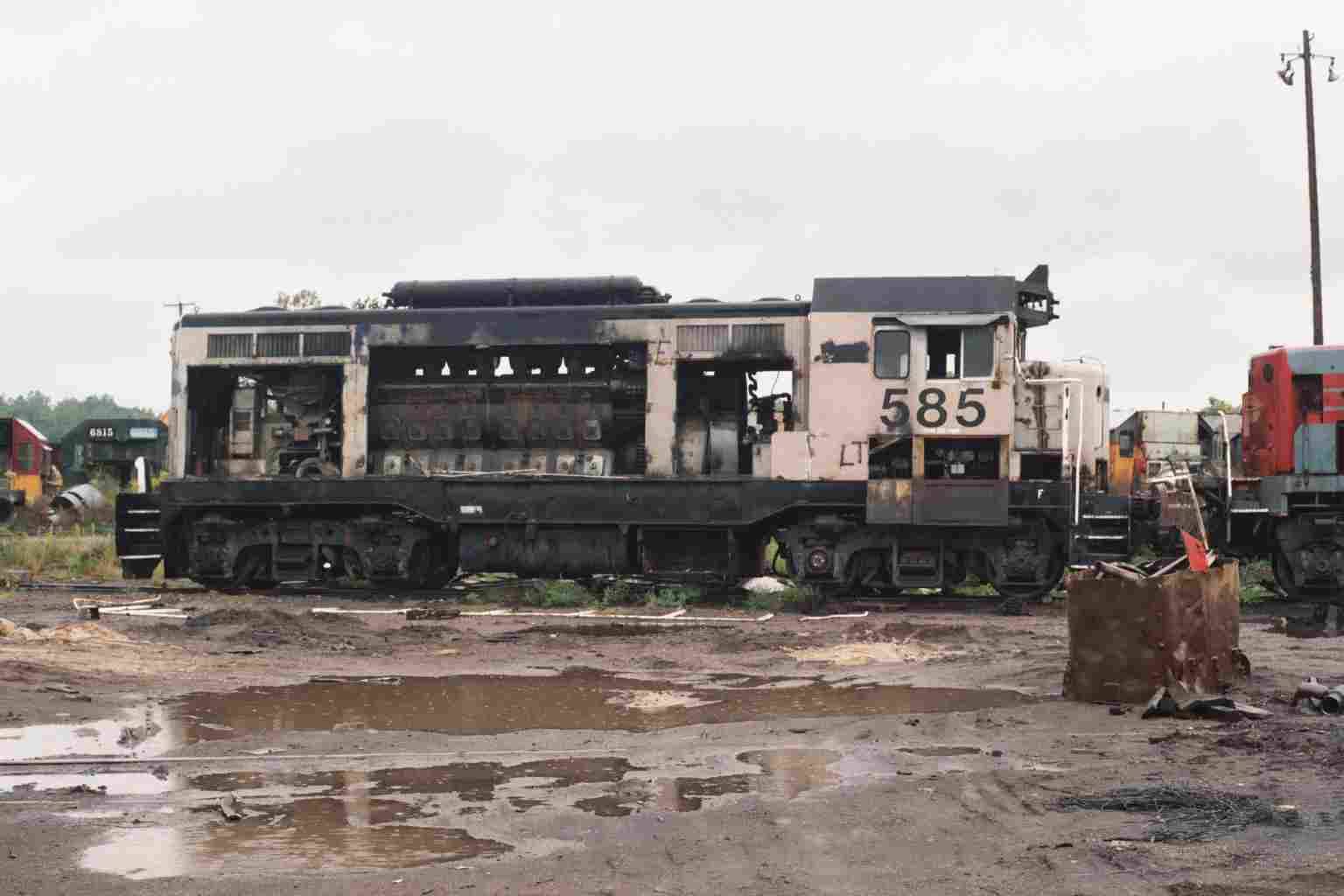 Former Amtrak CF7 585 September 19, 2003 |
And of course, there's lots of opportunity for using leftover diesel shells, basket case locos, and other parts from kitbashing projects, creatively cut up and weathered. I've found that bits and pieces of old Tyco, AHM, and Athearn "wide body" shells from my private stock of junk look remarkably good with appropriate detail, paint, lettering, and weathering. A light-duty highway bridge crosses over the area, as shown in the photo of the UP/DRGW tunnel motor, and can serve as a good scenic divider for one end of the layout.
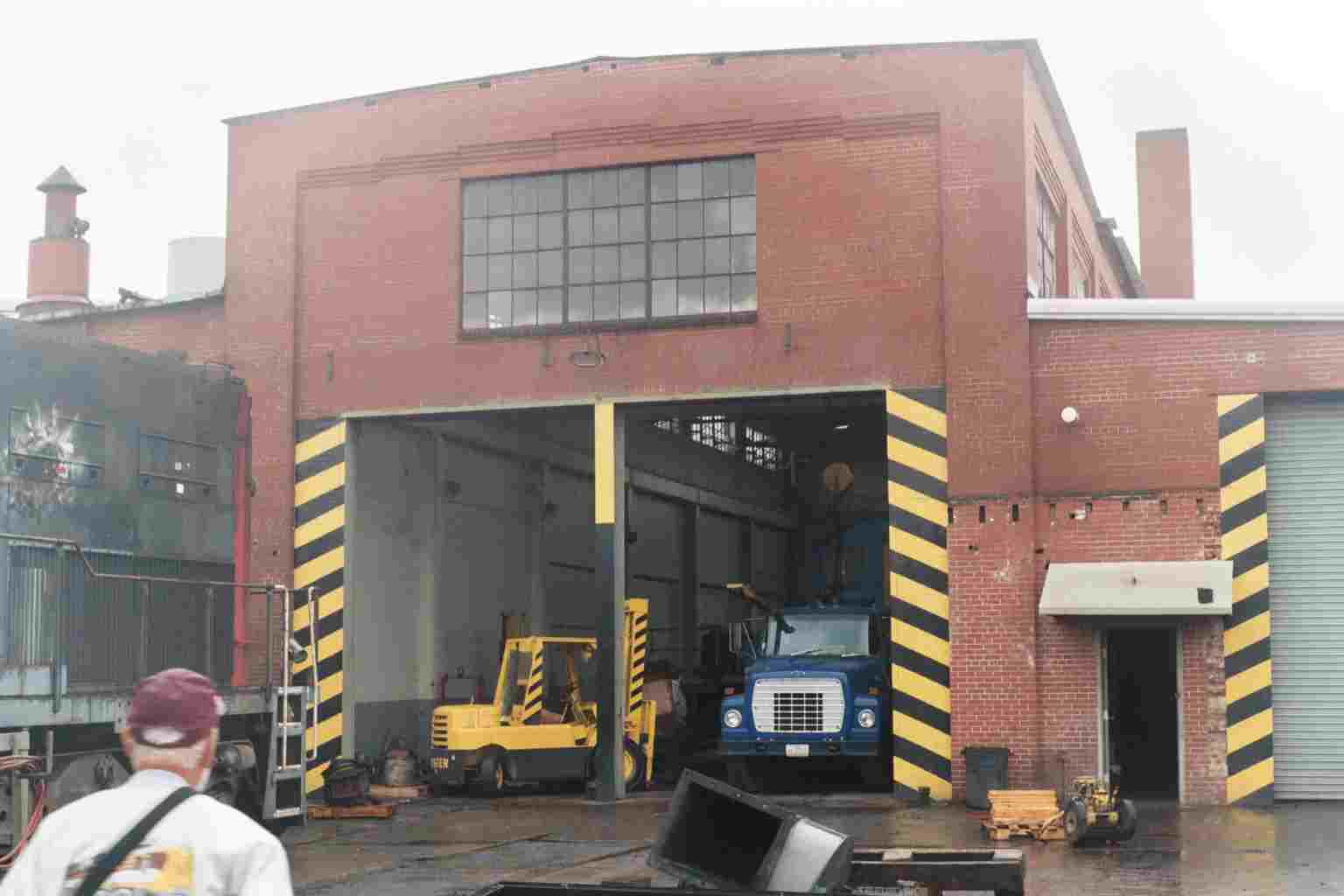 Looking South to front of LTE Rail Main Shop September 19, 2003 |
The wide end of the layout can also be ended with the low-relief front of a diesel enginehouse/shop. The tracks heading to the left in the photo of the "yard throat" above terminate in this building. At the far left of ths photo is one end of an ex-UP nee-SP tunnel motor, its diesel engine idling -- this one's apparently a keeper, despite its coat of graffiti.
Inside the shop is a working overhead crane, but all that's happening is a former Conrail SW1200 being cut up (photo below), no different from what's happening to other locos in the rain outside.
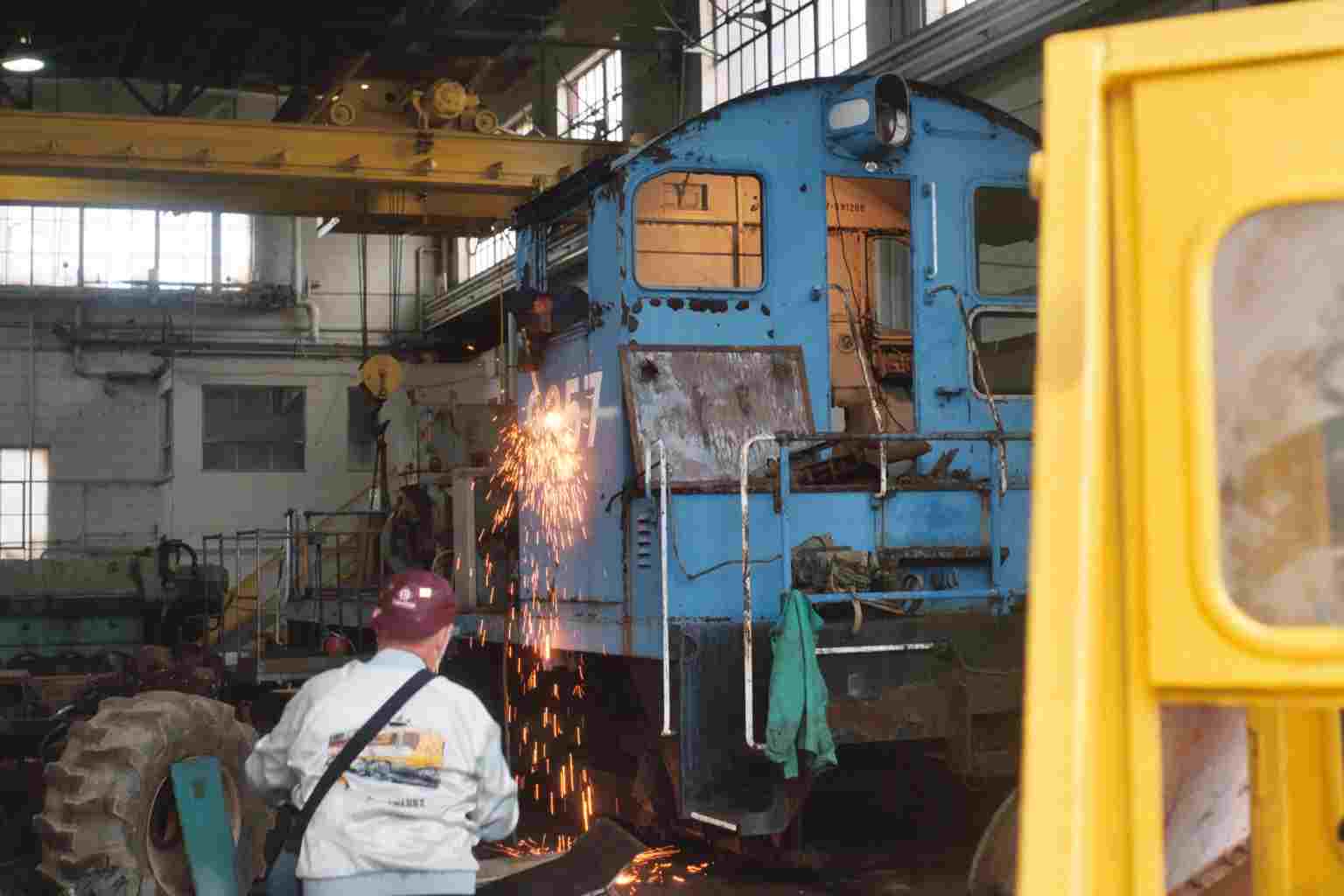 Torching ex-Conrail SW1200 September 19, 2003 |
I would estimate the minimum space required for this layout would be driven by the need to have one "active" loco be able to switch two "hulks" or dummies at a time. This means, given the dimensions of typical US prototype HO diesels, that the lead track would need to be three times nine inches, or 27 inches, long. The longest yard track should be the same length. Allowing for a switch nine inches long, the total length of the layout should be about 63 inches. To keep the whole area under 4 square feet (an arbitrary limit, of course), the width of the baseboard would need to be no more than nine inches. This would allow for some spreading of the three yard tracks for scenic effect. I would skew the whole layout at an angle to the edges of the baseboard and curve some of the tracks, too. Naturally, if you could tolerate one active loco shoving one hulk instead of two, you could shorten the layout by about 18 inches.
This kind of layout could be a good feature at functions like prototype modeler meets, where most models are static and simply sit on white hotel linens. A functional layout with scenic detail in such a small area would be a welcome change.
As an industry attached to a larger layout, this could be made slightly smaller, with more traffic in the form of gondolas loaded with outbound scrap. However, from an operational standpoint, dummy locomotives would serve to add complexity, since the special instructions in railroad employee timetables typically specify how units running dead in tow should be handled. It's another way to justify the very large locomotive rosters many modelers accumulate over the years, as well.
October 8, 2003